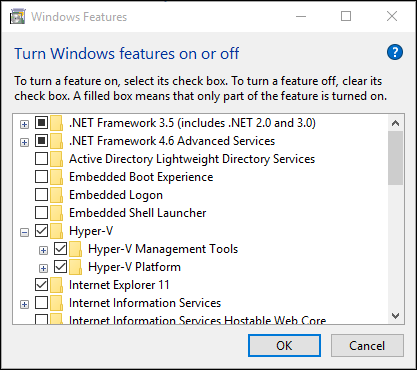Hyperv Vagrant And Docker
Trying to use the Spotify maven docker plugin led me to needing a Docker host accessible from the Windows box I use for deveopment.
An initial attempt to just use Microsoft’s Windows Containers, as described here, didn’t work: although I ended up with a docker client, attempting to run a Centos image such as this Tomcat image failed.
The error I got was that Windows Containers cannot run non-Windows images.
It’s possible that using regular Docker for Windows (rather than Windows Containers) might work; still need to investigate that possibility.
In the meantime though I decided to go a different way and install Vagrant using Hyper-V to host a Ubuntu image, then run Docker within that Hyper-V image.
Install Vagrant
Download the installer from https://www.vagrantup.com/downloads.html, and run.
Enable Hyper-V
Enable either through the UI:

or using Powershell:
Enable-WindowsOptionalFeature -Online -FeatureName Microsoft-Hyper-V -AllConfigure an External Hyper-V network switch
Open Hyper-V Manager, then Virtual Switch Manager…

Then create a new External virtual switch, eg:

Environment Variable
Open a Powershell session (as Administrator) in that directory, and type:
$env.VAGRANT_DEFAULT_PROVIDER=hyperv
[Environment]::SetEnvironmentVariable("VAGRANT_DEFAULT_PROVIDER", $env.VAGRANT_DEFAULT_PROVIDER, [EnvironmentVariableTarget]::Machine)VagrantFile
Create a directory c:\vagrant\machines\dockerhost, and in that directory create this VagrantFile:
Vagrant.configure("2") do |config|
config.vm.box = "hashicorp/precise64"
config.vm.provider "hyperv"
config.vm.network "public_network"
config.vm.provider "hyperv" do |vb|
vb.memory = "4096"
end
config.vm.provision "docker",
images: ["ubuntu"]
endCreate the Machine
Open a Powershell session (as Administrator) in that directory, and type:
vagrant upBringing machine 'default' up with 'hyperv' provider...
==> default: Verifying Hyper-V is enabled...
==> default: Configured startup memory is 4096
==> default: Importing a Hyper-V instance
default: Please choose a switch to attach to your Hyper-V instance.
default: If none of these are appropriate, please open the Hyper-V manager
default: to create a new virtual switch.
default:
default: 1) nat
default: 2) ExternalVirtualSwitch
default:
default: What switch would you like to use? 2Select the external virtual switch created earlier.
The bootstrapping continues:
default: What switch would you like to use? 2
default: Cloning virtual hard drive...
default: Creating and registering the VM...
default: Successfully imported a VM with name: precise64
==> default: Starting the machine...
==> default: Waiting for the machine to report its IP address...
default: Timeout: 120 seconds
default: IP: 10.0.0.25
==> default: Waiting for machine to boot. This may take a few minutes...
default: SSH address: 10.0.0.25:22
default: SSH username: vagrant
default: SSH auth method: password
default:
default: Inserting generated public key within guest...
default: Removing insecure key from the guest if it's present...
default: Key inserted! Disconnecting and reconnecting using new SSH key...
==> default: Machine booted and ready!
==> default: Preparing SMB shared folders...
default: You will be asked for the username and password to use for the SMB
default: folders shortly. Please use the proper username/password of your
default: Windows account.
default:
default: Username: dan@haywood-associates.co.uk
default: Password (will be hidden):Enter username and password.
The bootstrapping then completes:
==> default: Mounting SMB shared folders...
default: C:/vagrant/machines/dockerhost => /vagrant
==> default: Running provisioner: docker...
default: Installing Docker onto machine...Accessing the Machine
It should then be possible to log in:
vagrant sshresulting in:
Welcome to Ubuntu 12.04.4 LTS (GNU/Linux 3.11.0-15-generic x86_64)
* Documentation: https://help.ubuntu.com/
Last login: Thu Mar 6 09:02:28 2014You can then run docker, eg:
docker versionresulting in:
Client:
Version: 1.12.5
API version: 1.24
Go version: go1.6.4
Git commit: 7392c3b
Built: Fri Dec 16 02:23:22 2016
OS/Arch: linux/amd64
Server:
Version: 1.12.5
API version: 1.24
Go version: go1.6.4
Git commit: 7392c3b
Built: Fri Dec 16 02:23:22 2016
OS/Arch: linux/amd64